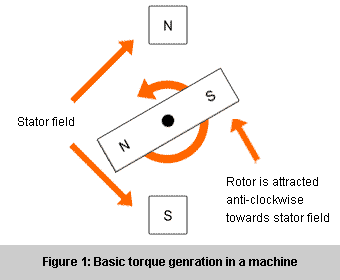Induction Motor theory

An AC motor has a stationary part (stator), and a rotating part (rotor). In most AC machines, the stator windings set up a rotating magnetic field in the air-gap of the machine when the stator windings are energised. The field rotates at a speed that is fixed by the frequency of the supply used to establish the field and the number of 'pole-pairs'. The number of 'pole-pairs' are fixed when the stator is wound in the factory. The speed the field rotates at what is known as the synchronous speed.
The synchronous speed determines the speed of the rotor. In an asynchronous (or induction) machine, the rotor will rotate at a speed close to synchronous speed - the difference between the actual rotor speed and the synchronous speed is referred to as the slip speed.
Induction machines generate torque by the interaction of the two magnetic fields: one established by stator currents and the other established by rotor current. In the induction machine the rotor currents are induced by the stator magnetic field and these rotor currents flow in conducting bars within the rotor structure. These currents then establish a rotor field that is attracted towards the stator field (just like two magnets will attempt to align themselves). Figure 1 shows this basic concept. The rotor magnet represents the rotor field – it 'looks' like a bar magnet. This bar magnet is attracted to the magnetic field generated by the stator. Therefore, as the stator magnet rotates so to does the rotor.
As the slip speed increases the rotor current rises therefore the torque increases. This can continue until the pull-out torque is exceeded. If the pull-out torque is exceeded the motor stalls. Motor torque is therefore roughly proportional to rotor current.
The induction machine has a simple, reliable and robust construction. The rotor is simply a laminated structure with cast bars to allow rotor current flow. There is no need for connections to the rotor through slip-rings and brush arrangements, nor is there a need to commutate (change polarity) of the rotor field as this is taken care of by the alternating nature of phase currents.
Our range of AC induction motors have been 50 years in their development and all are manufactured to high standards. Please click on the links above to view our existing range of motor specifications that we can offer from our range of AC Motors. These motors can be adapted to your own specific requirements using SPEED motor design software, ensuring that we can provide you with an optimised motor solution for your products.
Lemac would like to thank Dr Fletcher at Strathclyde University for taking the time to compile this information and allowing us to make it available to you at lemac.com.